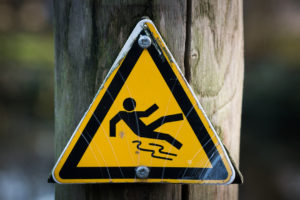
It’s possible to avoid injury, circumnavigate insurance, claims and become safer. Whether you are an employee who’s recently suffered an injury or you’re a business operator who wants to make a safer environment, these slip and fall prevention tips can help you.
7 Slip and Fall Prevention Tips
Tip One: Take Care of the Parking Lot
Commercial slip and fall prevention extends beyond the front door. If the weather is cold, make sure your workplace has plowed away any snow. Additionally, it is important to make sure the parking lot is cleared of any residual ice. As a minimum standard: Reduce any surrounding snow to three inches in depth.
Tip Two: Keep it Clean
The inside of your workplace should be as clean as possible, too. Workplace-related slip and fall cases often happen because of dirty floors. Clean floors can pose similar hazards. Once you’ve picked up the ropes, boxes, and cords, clean the floor. Don’t leave soap residue, however. Don’t neglect to dry the floor, either, because even a damp floor can result in workplace slips.
Tip Three: Mark Clear Passageways
Once you’ve cleaned your work environment, take your occupational safety to the next level. Customer’s fall protection is directly related to their understanding of their environment. Thus, you should use floor marking tape to highlight walkways. Mark the area’s swinging doors and stairways, too, to help customers—and workers—navigate in low-light environments.
Tip Four: Train Other Employees
Employees should be trained to recognize and avoid slip and fall hazards. Slips, trips, and falls are the same as any other safety hazard. Remember: Your employees are exposed to the workplace more than anyone else. Statistically, they’re more likely to encounter a workplace-related accident.
Tip Five: Stick to a Schedule
Your workplace should adopt a consistent maintenance routine. Even if the routine is conducted on a once-per-month basis, it’ll make all the difference. Routine maintenance and inspection should be a regular safety program component, sure, but it should be governed by an overarching system of logic.
Monitor your business’s traffic, assuring all walkways and entrances can accommodate for expected volume. Similarly, conduct periodic walkthrough surveys of your premises. If possible, use only slip-resistant floor treatments. Schedule monthly maintenance during low-traffic hours, and make sure employees are aware of any ongoing maintenance.
Tip Six: Report Everything
If an incident happens, it should be reported. This information is vital to future incident prevention. It’s also essential to claim prevention and defense. As a standard: print all incident reports. Document all surrounding details. Collect the names of any employees, victims or witnesses involved. Then, take photographs of the incident area. While these tasks will protect you from legal harm, they can also help you understand where, why, and how these slip and fall incidents occur.
Tip Seven: Cover the Cables
Your business needs to be well-lit, but it needn’t be cluttered. A surprising amount of slip and fall cases occur due to power cables. Keep them tucked away. If possible, lay them beneath your business’s carpet.
Eventually, accidents happen. By taking great care in prevention, however, you can reduce—or even eliminate—slips and falls for years to come.
